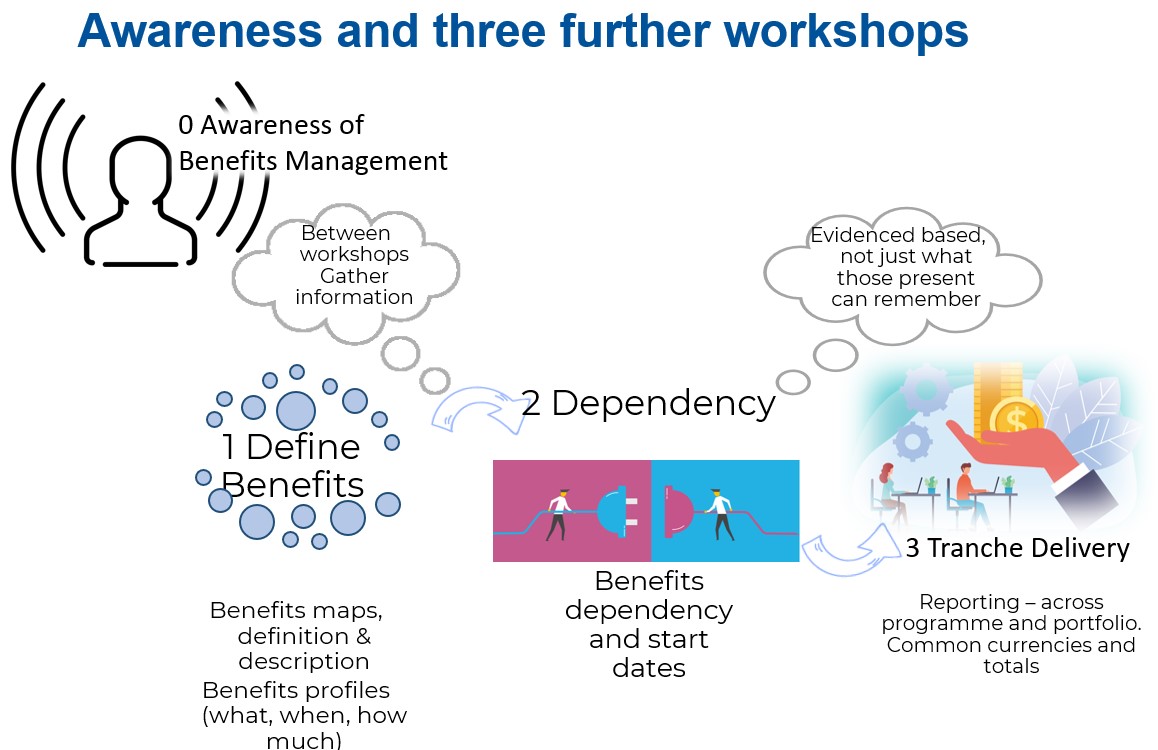How to run interactive benefits management workshops in the ‘new normal’

Including options for both high- and low-security contexts – by Hugo Minney and Merv Wyeth
Lockdown is easing; my workplace, Sellafield Ltd, is bringing the construction crews back, restarting most projects and all active work. But for those who are usually office-based, the guidance is that we will be working from home for some time. So what does this mean for those of us responsible for benefits management?
Benefits management is about engagement
My work involves conversations. Benefits management is about stakeholder engagement – getting agreement on a whole host of issues, including what the objectives are, what the benefits are, how much they are worth, who is responsible and whether the actual achievements match the promise in the business case.
That means corralling project leadership teams and other stakeholders, in one place, to tackle problems and develop solutions using their collective wisdom, a wall and sticky notes.
Do the business case and target operating model stack up?
At first sight, some parts don’t appear to require discussion. Objectives are from the business case, and outcomes are detailed in the target operating model. However, if the objectives in the business case were couched in feel-good terms that aren’t specific, to allow for flexibility, how can we measure lead indicators? We need something more specific.
Outcomes, or the ‘target operating model’ (what the world will look like because of what the project does), are probably better defined. Even then, what’s written in project documentation and the reality may be significantly different.
Developing benefits is never that simple. Benefits happen in the main business, not to the project team, and people need to be involved if you expect them to own the benefits.
Taking benefits management workshops online: can it work?
My benefits management process comprises four interactive workshops with added support and coaching in between. Each workshop builds on the previous one and is designed to challenge or confirm the work undertaken in-between; the entire process needs to be completed to get the best results. The workshops are:
- Awareness – Get everyone on the same page about the main concepts, terminology and, most importantly, the scope. Benefits management begins earlier than many people have been led to believe, and completes later.
- Benefits map, benefit profiles – I challenge the client to show how their activities (initiatives) will reach the objectives that they received the money for (using the map and linkages on the map). We then define the higher priority benefits in more detail.
- How much, and of what? – We use a few common currencies (for example, reputation) to report benefits, which means different investments can be compared. We forecast when the benefits will come in, and what we can measure during project delivery (lead measures). This is in preparation for the fourth workshop.
- Actuals and decision-making – Compare the actual lead measures to the forecasts, and use the difference to drive benefits-led decisions instead of specification-led decisions.
How you go online is going to depend on what technology you have available. And this will depend on the security considerations and your budget. I work with different organisations, so I’ve used a number of different approaches and they all work. Don’t be afraid to try something different.
No restrictions on security or budget? Try videoconferencing and an interactive whiteboard
Videoconferencing means the discussions are richer – you can see the threatening body language or eye roll. An interactive whiteboard means everyone gets involved. Note that you are going to keep the same interactive whiteboard for the same team and stakeholders throughout the workshops.
They will need access in between workshops, to change their mind about items on a map or add more detail to a profile. And the whiteboard is used for more than just a benefits map – they’ll build the interactive elements of benefits profiles (deciding the owner, risks, issues, assumptions, dependencies, measures and forecasts) in another space on the interactive whiteboard, so you need a platform with this capability, such as Miro or Mural.
I have used Google Slides and a PowerPoint document in Microsoft Teams as well, using multiple slides to keep the different bits of information available to everyone.
Tech considerations for a highly secure environment
In the most restrictive environment (no shared screens, no interactive documents), I use a specialist benefits management (actually strategic execution) tool to build the benefits map. To keep everyone on the same page, I circulate a current version every few minutes by email, and we discuss it on conference call. It’s a bit slower, but it’s still possible.
As I said above, don’t let anything get in your way. I am still able to manage these as ‘interactive’ sessions and you should be too.
The challenges that are common in any workplace are certainly exacerbated by the restrictions of technology in a civil-nuclear security environment. However, over the last few months I have proved that it can be done. Where there’s a will there’s a way.
There are several discussion forums to share what works for you and get more ideas. The Government Project Delivery Community network has a forum on this topic (log-in required). APM’s Benefits and Value SIG is always ready to welcome volunteers.
Authors
Hugo Minney is an experienced project manager and executive director, and a charity board chair. He uses benefits realisation management and a social impact framework to bring about change in organisational performance and culture. He is co-chair of APM’s Benefits and Value SIG and chairs the British Standards Institute panel on benefits management.
Merv Wyeth is an experienced programme manager and a subject matter expert in managing benefits, better business cases and OpenStrategies. Merv is secretary of APM’s Benefits and Value SIG.
Image: fizkes/Shutterstock


0 comments
Log in to post a comment, or create an account if you don't have one already.